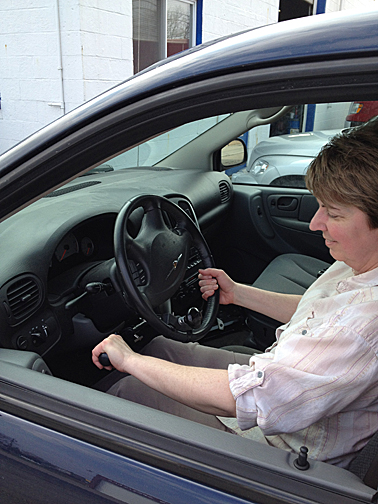The UT Medical Center Driver Rehabilitation Program is the only hospital-based one of its kind in northwest Ohio that is licensed to complete behind-the-wheel assessments in a specially modified car and train individuals with disabilities to return to driving with adaptations.

Gail Heath can chauffeur herself around again thanks to the Driver Rehabilitation Program and adaptive aids installed on her vehicle.
The goal of the rehabilitation is to help people maintain their independence through driving and determine if an individual’s health has affected his or her ability to drive safely. Occupational therapists working in the program are trained and certified to assess driving skills, make vehicle modification recommendations, and provide training.
“It is difficult for most people to understand the feeling of being stuck in your home for hours at a time, dependent on others to take you to the simplest places,” said Sylvania Township resident Gail Heath, who was a patient of the Driver Rehabilitation Program. “What an amazing feeling it was to re-learn to drive with my adaptations and have my sense of independence back.”
Drivers are assessed for their capabilities to continue driving and for whether they have the abilities to learn to drive with or without adaptations.
After an initial assessment, the therapist may recommend the patient needs adaptive driving aids, which can include hand controls, special mirrors, or reduced-effort steering and braking systems. The therapist then trains the patient on how to use the driving aids in UTMC’s modified car.
“The most common diagnoses for patients in the program in 2011 included stroke, dementia, traumatic brain injury and Parkinson’s disease,” said James Kesler, occupational therapist and certified driver rehab specialist. “All patients receive the same thorough care through the process.”
Heath, who has been diagnosed with multiple sclerosis and lost muscle strength on her right side last year, complimented Kesler as “one of the most patient men I have ever encountered in my life.
“He never made me drive when I did not feel comfortable, but he still knew to push me past my limits in order to succeed,” she said.
“Our program works with state vocational rehab clinics and self-referred individuals with the goals to drive safely and successfully,” Kesler said. “Our job is not complete until we have given a sense of freedom back to every one of our patients.”
For more information on UT Medical Center’s Driver Rehabilitation Program and other rehabilitation services offered at the hospital, visit utmc.utoledo.edu/centers/rehab/outpatient.html.